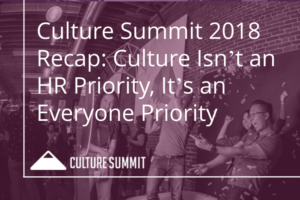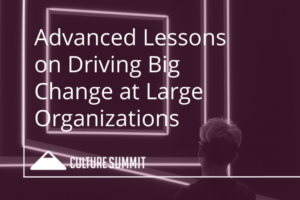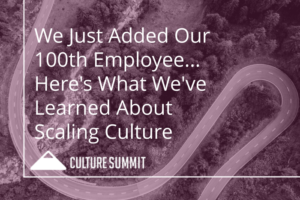Culture Summit 2018 Recap: Culture Isn’t an HR Priority, It’s an Everyone Priority
The 4th annual Culture Summit took place July 10-12, 2018, bringing more than 500 culture champions together to talk about how we can bring more humanity into the workplace, ask questions from experts who have been-there-done-that, and connect 1:1 to build communities where that have an even bigger impact.
We can’t share the delicious food through the blog, but we can give you a look at key ideas and takeaways from attendee’s favorite keynotes each day:
Culture Summit Day One
“Unleashing the Power in Every Team” with Atlassian’s Helen Russell
Helen Russell, Chief People Officer at Atlassian, kicked off the conference with a powerful keynote about the role recruiting and hiring plays in building culture – in building a culture that leads to business success, in particular. As a part of the Atlassian team, Russell has studied and worked with hundreds of different kinds of teams over the years and shared a few points about what companies can do to acknowledge big transition points – which for Atlassian was going public and scaling to 2000 – while staying true to core values at the team level.

“Building Culture Across Remote Teams” with Julian Lute, Sarah Elizabeth Graham, Katie Womersley, and Shane Metcalf
In the afternoon panel discussion, “Building Culture Across Remote Teams,” Julian Lute from Great Place to Work facilitated a discussion with Twitter’s Sarah Elizabeth Graham, Buffer’s Katie Womersley, and 15Five’s Shane Metcalf. Panelists shared real-life examples of how they encourage a sense of belonging among new remote employees (Buffer), how they communicate and monitor expectations (15Five), and how they work to create balance between remote teams and on-side or headquartered teams (Twitter).

“Leadership in 2018: How Managers Can Lead Inclusively in Times of Volatility” with Awaken’s Michelle Kim
Michelle Kim, Co-Founder and CEO of Awaken, tackled the challenging topic of how managers and executives can lead inclusively in politically volatile times, sharing real-life examples of how leaders can create spaces for awkward conversations that actually build culture rather than suppress it. Kim focused on the important role managers play in building culture – after all, 70% of variance in employee engagement scores is due to managers and 93% of employees say trust in their direct boss is essential to staying satisfied at work and doing their best work – and what companies can do to prepare managers to model inclusive behaviors and encourage belonging within your company culture.

Day One also featured practical keynotes from the following speakers:
- Rajesh Subramaniam with FedEx spoke to how company culture can bring unity from diversity
- Christina Kosmowski with Slack showed us how to design an employee experience using customer experience best practices
- Carrie Staller with The Go Game explained the importance of psychological safety at work and how prioritizing playfulness and structured team games can create space for a healthy culture to grow
- Robin Zander kicking off an experimental new Culture Summit session, “The Fishbowl,” in which attendees volunteered to step up on the stage and share their hard-won advice from the field
Culture Summit Day Two
“Culture in Everything You Do” with Pinterest’s Cat Lee
Day Two kicked off with a compelling keynote from Cat Lee, Head of Culture at Pinterest, who spoke to the importance of weaving culture into absolutely everything your company does – from the very first interview to company-wide traditions to the last day of work. Lee shared several steps leadership teams can take to help employees take ownership over core values and build the habit of using those values to make every decision. In particular, Lee focused on the importance of using culture as a guide for who joins the company, how they contribute while they’re there, and the understanding of culture they’ll take with them to new opportunities when they leave.

“The Importance of Rituals & How it Reinforces Company Culture” with Warby Parker’s Susan Lee
Later in the morning, Susan Lee, the VP of People at Warby Parker, explored how even the smallest, simplest traditions can be powerful opportunities to build culture if they’re based on core values. Lee also walked us through how Warby Parker builds rituals that build culture, but emphasized that it’s not the ritual that’s precious – it’s the intention behind the ritual and the cultural impact of the ritual. While some rituals stick with you while your company grows, others will come and go as your company expresses its values in new situations.

“Creating Real-Time Employee Engagement Without Spending a Dime” with Zen Workplace’s Karlyn Borysenko
Karlyn Borysenko, Owner and Principal at Zen Workplace, took to the stage to close out the Culture Summit by sharing practical tips for improving employee engagement without the pressure to bring in time-consuming engagement events or expensive consultants. After detailing the benefits of highly engaged employees – such as increased productivity and retention and decreased turnover – she walked attendees through the basics of how the brain works and simple psychological shifts that leaders and managers can make to help employees have a more engaging day-to-day experience, grow healthy relationships, and feel psychologically safe at work.

Day Two also brought us the following actionable keynotes:
- Jack Altman facilitated a discussion with Reddit’s Katelin Holloway, Monsanto’s Melanie Moore, and Atrium’s Justin Kan on the ways in which they’ve seen investments in company culture deliver a measurable ROI
- Aaron Kahlow shared how we can encourage mindfulness, or moment to moment awareness without judgement, in the workplace and how it benefits company culture
- Carrie Staller and Kelly Rogala with The Go Game hosted a networking game that brought attendees together in small groups to share individual experiences and challenges
- Twilio’s LaFawn Davis and Chan Zuckerberg Initiative’s Maurice Wilkins hosted a Fireside Chat to explore diversity fatigue and how companies can remove barriers to opportunities and access in the workplace today
- Josh Lavra from IDEO shared case studies for six culture behaviors that allow teams to thrive creatively
If you weren’t able to join us this year, we hope to see you next year! And if you were, we’d love to hear about your favorite Culture Summit moment in the comments below.
Want to keep reading? Check out these powerful attendee recaps:
How to Integrate Your Company Mission Into Your Culture by Cristina Ashbaugh
At Culture Summit, anyone can be a change agent: key takeaways from a culture conference by Sam Trieu
Dagger Goes West: Learnings From Culture Summit 2018 by Rachelle Knowles






